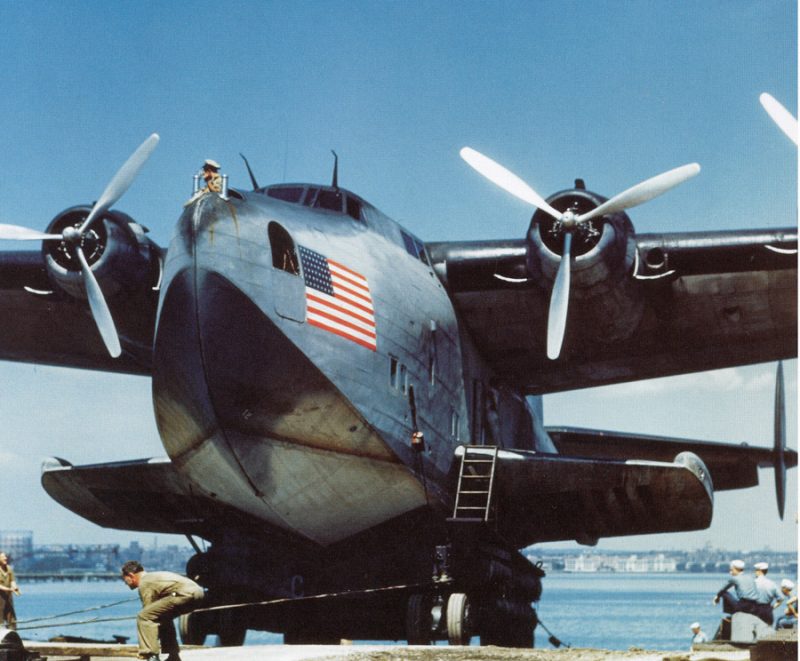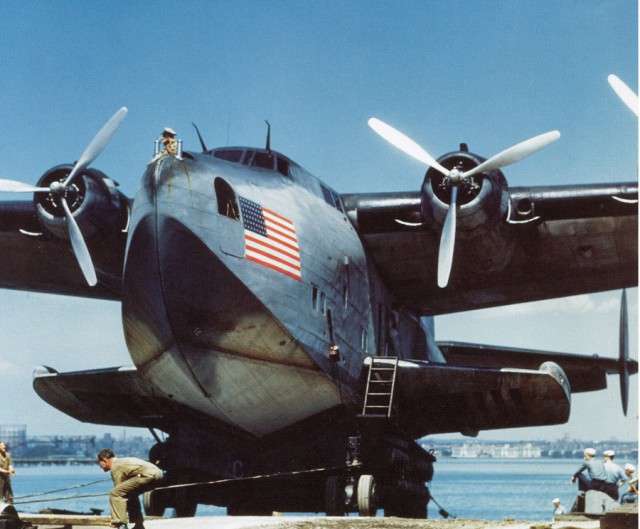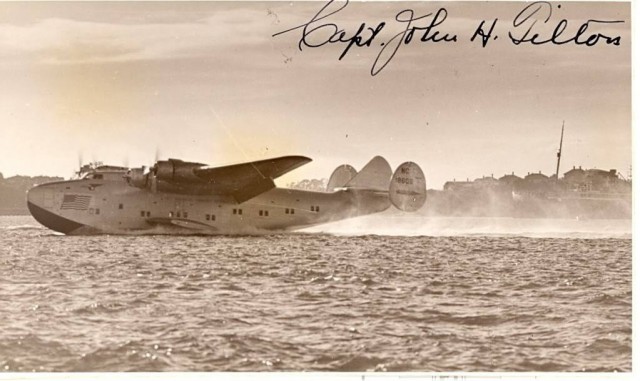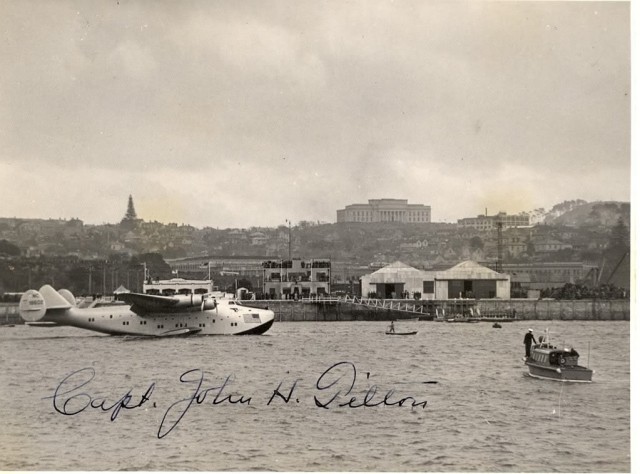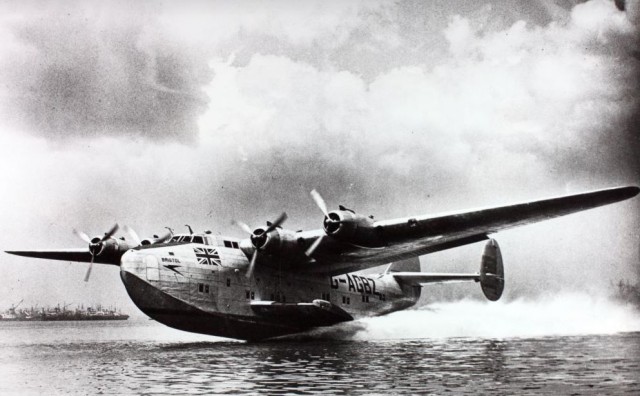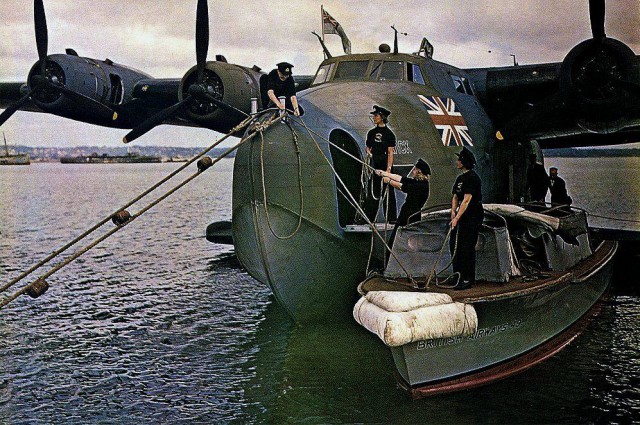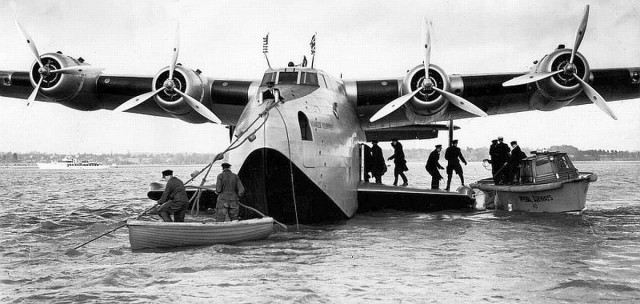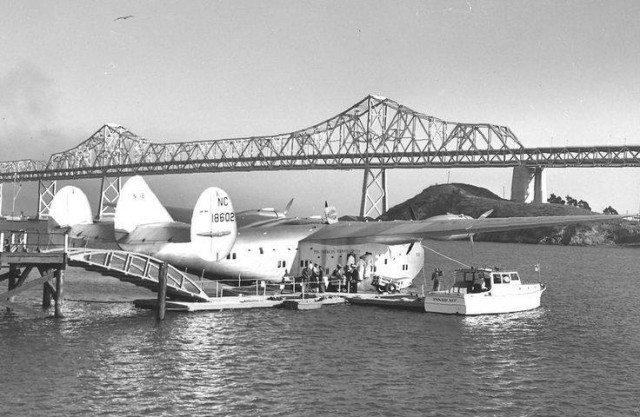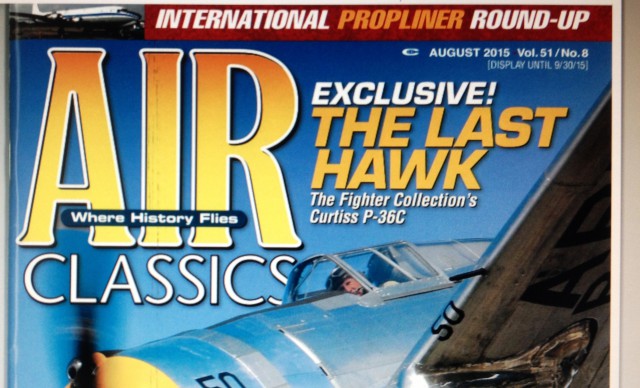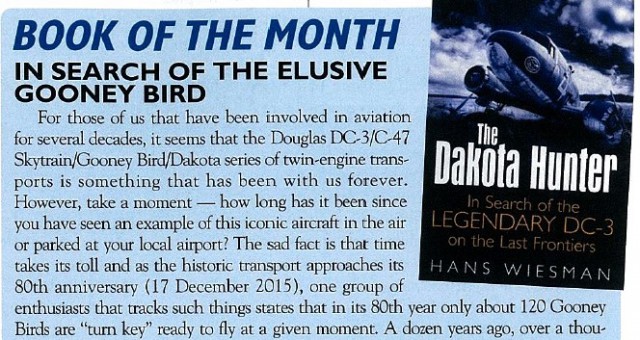The Boeing B-314 in military colors with huge Stars and Stripes on the front fuselage, resting for maintenance on the ramp of La Guardia Marine Terminal , NY, Jan 1941. The B-314 flying Boats were built between 1938 and 1941. First operational flight was made in March 1939 from NY to Southampton, UK. for which 4 aircraft were used. Two more were flying the Pacific routes before the war started. Only 12 of those huge aircraft went operational, first with Pan Am, who later sold 3 of its 6 B-314 A’s (an improved model with stronger engines) to BOAC.
As the war broke out for the USA in early Dec. 1941, all Pan Am flying boats of the type were incorporated in the US Navy services for worldwide ops, but retained their Pan Am flight and maintenance crews, as being most experienced with the complex flying boat operations, that by definition carried more risks and hazards than “land based” aircraft ops. As a big plane with 4 Wright Cyclone 1600 HP engines ( in the A-model) , it could make transatlantic hops as no other passenger plane could in the late 1930’s with its max range of 3500 miles, later extended to 5200 miles.
With 74-77 passengers on board. the aircraft had a max weight of 38 tons and a cruise speed of 190 mph or 300 km/h., quite impressive figures for the pre-war era. Such figures made this the perfect ship for transporting essential personnel and supplies to all corners of the world and theaters of war, that came in reach in just a matter of days.
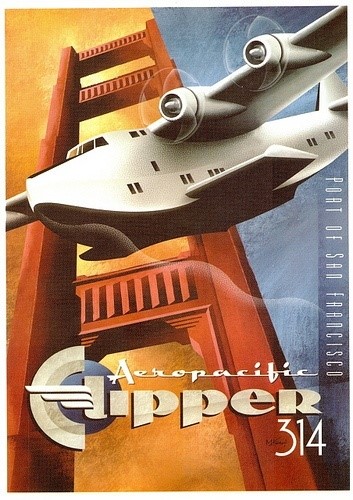
It was for the Happy Few only and for a short period, as the war pressed the giants into a new role of world wide fast delivery platform for Diplomats, Intelligence Officers, the Top Brass Military, and Heads of State as US President Roosevelt ( to the Casablanca Conference with Dixie Clipper) and British PM Churchill. All in all, the type flew 85.000 passengers during the war in some 5000 ocean crossings (est. 12.5 million miles), giving some idea of the strategic importance of this aircraft that made the world and its time span of travel markedly smaller. Allegedly, even uranium for the production of the first atomic bombs was hauled by this aircraft.
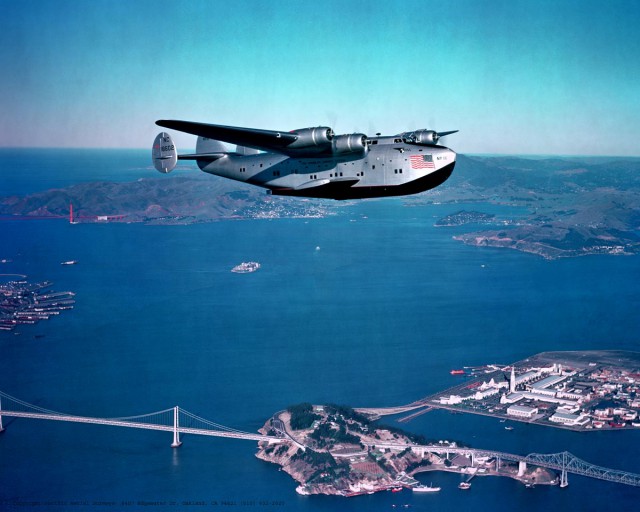 The B-314 Clipper flying over the San Francisco Bay with the Golden Gate bridge in the back drop on the left (later this aircraft got the name California Clipper) .
The B-314 Clipper flying over the San Francisco Bay with the Golden Gate bridge in the back drop on the left (later this aircraft got the name California Clipper) .
This stunning photo accentuated the elegant lines of the aircraft. In spite of its rather bulky fuselage, the Boeing designers succeeded in the making of a master piece of flight , not only in performance but surely also in the looks. Compared to its predecessors ,(who made the same Atlantic and Pacific crossings), the Sikorsky S-42 ( intr. 1934) and the Martin M-130 (intr. 1935), the B-314 was much bigger but had a very sleek and streamlined design. It was the era of streamlining with designers as Ed and Ralph Budd who created the legendary streamliner train the Burlington Zephyr and Raymond Loewy who applied the Art Deco influence on Industrial Designs as cars, locomotives, domestic appliances , buildings etc. For many , the B-314 was the ultimate shape of an airborne Art Deco influenced design. Bravo for the Boeing Team that created such enticing beauty!
But there was also some important technological progress made with the type: the fully-feathering propellers, requested by Pan Am’s visionary CEO Juan Trippe as a safety feature. Moreover, the wing’s dimensions and thick cord allowed mechanics access through a crawl way to the engines in flight. The fully-feathering props made it possible for a mechanic to do inspections and repairs in flight. Between June, 1939 and June, 1941, over 400 of such in-flight engine repairs were performed! The sponsons at the lower mid fuselage were copied from the earlier German Dornier design; they gave lift as an airfoil, stability during the water operations and where the stepping stone for passengers that made their entry to the aircraft via those “fins”.
Two autographed photos pop up from Captain John. N. Dillon, most probably taken in the port of Lisbon, Portugal, which was one of the overseas stations of the Pan Am network. There was a northern Atlantic route from USA to UK. From Southampton UK to Foynes (Ireland), Botwood ( Newfoundlandland) , Shediac, New Brunswick to New York’s La Guardia Marine Terminal. Another route existed during the war that flew over the mid Atlantic , via Natal ( NE Brazil), to Liberia and even on to Cairo (Egypt) and Teheran (Iran) to supply the Russians with critical materials, personnel and documents.
Two fabulous photos of the B-314 A’s in BOAC services, also ” interned” by the British Military for their war time operations. The aircraft were taken over from Pan Am and named Bristol, Berwick and Bangor. They were flown to West Africa and had e different color scheme in olive drab green , with the Union Jack exposed under the Cockpit.
Yankee Clipper moored at Southampton during one of its Military WW II missions, picking up Top Brass Officers for yet another crossing over the Atlantic. It could have been a screen shot taken from a vintage James Bond movie. This aircraft crashed in the Lisbon bay during a landing accident in February 1943 . It was one of the 3 serious accidents with a B-314, the Lisbon crash was the only one that ended fatally, it took 24 casualties. All in all, regarding the special operations, with awkward landings and take -offs only from rivers, lakes and seas and the intensive use of the 12 flying boats, it can be concluded that this was a most reliable aircraft flown and maintained by an extremely capable and dedicated group of Pan Am/ BOAC pilots and their mechanics.
On the Pacific side , the B-314 flew to Hawaii in 19 hours, starting from the San Francisco Bay (see photo above) and from there on to the Philippines and the Far East. As the war broke out , the East Asia destinations were given up, instead Auckland ( NZ ) came as a new flight station.
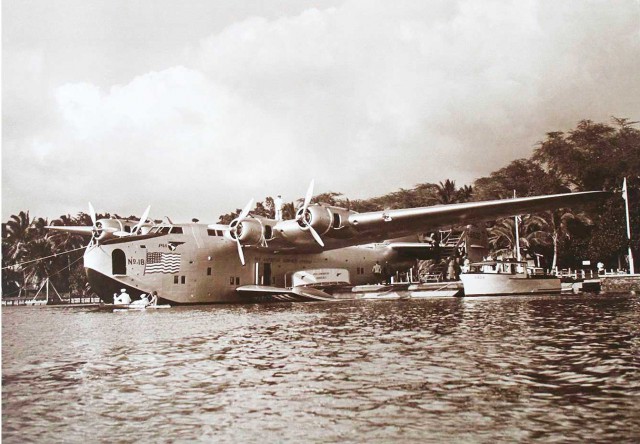 The photo above shows an idyllic scene of the B-314 moored in Honolulu, and surrounded by curious spectators that came in canoes and on surf boards to watch the magic airplane.
The photo above shows an idyllic scene of the B-314 moored in Honolulu, and surrounded by curious spectators that came in canoes and on surf boards to watch the magic airplane.
With the beauty and romance of early transcontinental flight and tourism, this plane must have set Hawaii better on the map of Tourism than any other transport could ever have achieved. Very unfortunately, none of the dozen B-314’s built survived beyond 1951, with all 12 being scrapped, scuttled, cannibalized for parts, or otherwise written off. After the war was over, the B-314 was made obsolete by that same war effort in which the type contributed so much. With the arrival of the long distance bombers as the Boeing Super Fortress B-29 in the final stages of the war against Japan, concrete runways were constructed all over the globe and along the shipping routes of this world.
New 4-engine “land” aircraft, using the latest technology piston aircraft and “flat cord” low drag wing designs, stepped out from the war as the new long distance passenger transports. With the new runways available, the Douglas DC-4 and the Lockheed Constellation were ringing the death bell for this Beauty, making her successful career very limited to the war years only. It must have been a bitter conclusion for many , end of an era that was slowly trickling in, the days of the Flying Boats were over. That counted also for the British Aircraft Industry , as they had developed in the late 1940’s the huge Flying Boat Saunders-Roe Princess G-ALUN that flew in 1953 , but never came into commercial service. It was scrapped in 1967, a dreadful end for yet a another beauty queen.
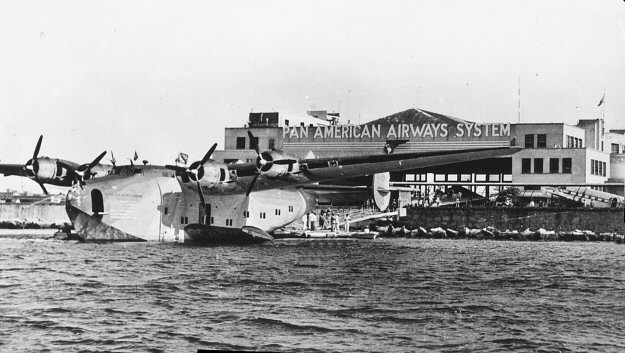 Fabulous shot of B-314 NC18604 “Atlantic Clipper” moored at the Santos Dumont Airport ramp in Rio de Janeiro, Brazil.
Fabulous shot of B-314 NC18604 “Atlantic Clipper” moored at the Santos Dumont Airport ramp in Rio de Janeiro, Brazil.
There is a Panair do Brasil Lockheed Lodestar in the backdrop at right. This airport was in 1994 exactly the location for a little disaster that I encountered with a British PBY-5A Catalina owned by Plane Sailing UK and flown by Capt Paul Warren Wilson. We had landed on the waters that you see on the photo, right under the impressive Sugar Loaf Rock on the other side of the Bay. A helicopter was hovering overhead for filming our imminent take off from the water, as part of the TV doc series titled “Catalina Odyssey” for which I was script writer and tour director.
As Paul gave full throttles for the take off run, I was sitting in the left hand blister and noticed big oil drops coming from the port engine, that splashed against the blister glass. I informed Paul by the headset, he took good notice and saw no signs of trouble yet on the gauges. The take off run was continued in his fine style and as we came off, Paul gently throttled the engine back. In a majestic slow turn, he lined up the Catalina for a perfect runway/ Terra Firma landing at this Santos Dumont Airport. The port engine had to be replaced, Paul and his mechanic Barry did that out there all by themselves! For more information of that epic voyage, you should read my new book “The Dakota Hunter”. in which I describe in details my aviation adventures from all over the world. In search for the legendary DC-3 on the last frontiers, but there is way more about vintage aircraft than just the iconic DC-3 / C-47/ Dakota.
Below, you can read why the leading US vintage aircraft magazine AIR CLASSICS has selected my book as the “BOOK of the MONTH” in their August 2015 issue. A fine FIVE-STAR review that you can read here below. For a sneak preview, please come to my site www.dc3dakotahunter.com , click the home button and scroll down, to where you can get access to 6 random pages of my book. Click on the button “Order the Book” above for direct access to the Amazon USA/ UK site where you can order my book.
